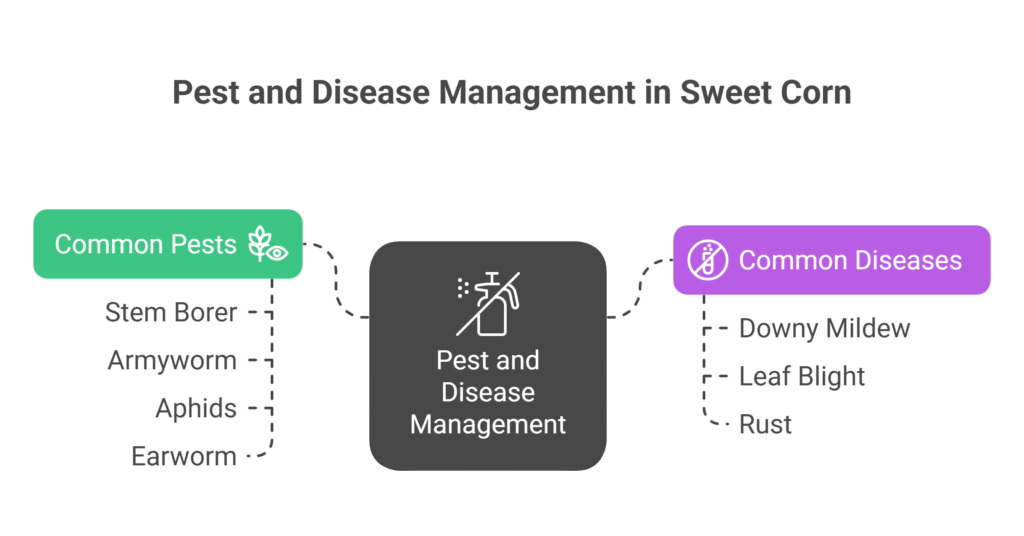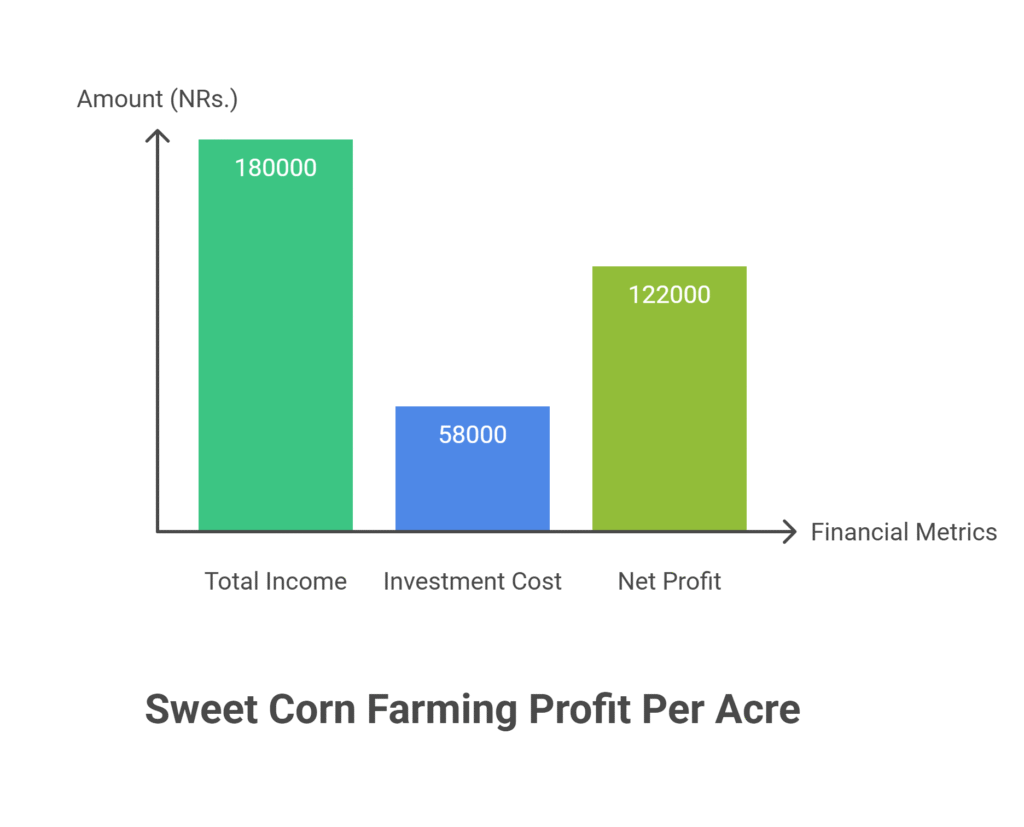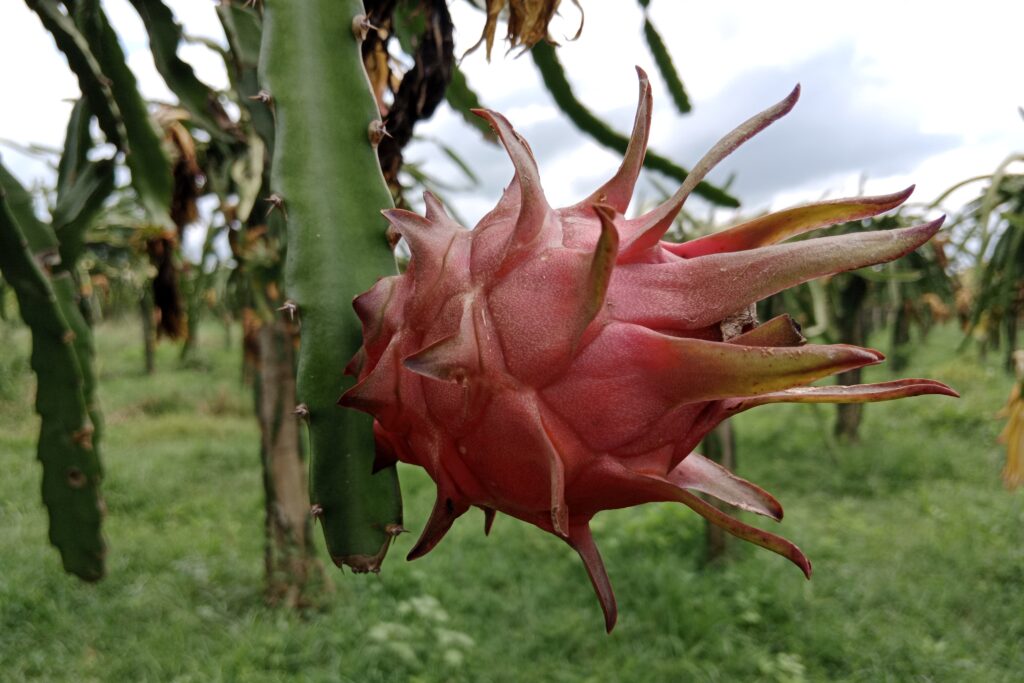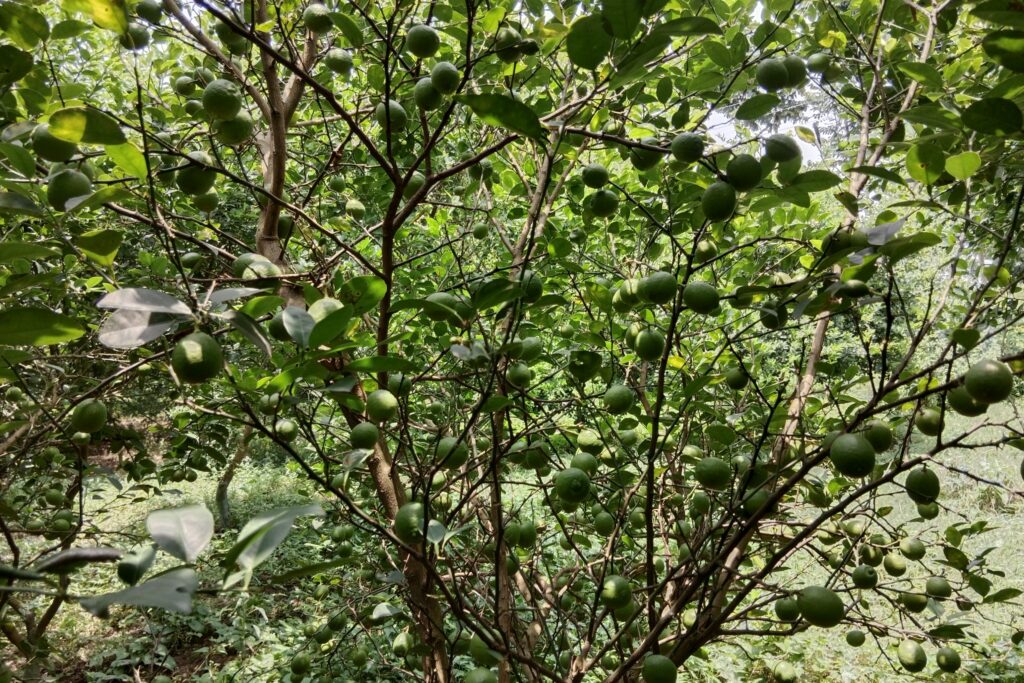Sweet Corn Farming
The sweet, soft kernels of sweet corn (Zea mays var. saccharata) make it a popular vegetable crop. Sweet corn is harvested at the immature “milk stage” for fresh consumption, canning, or freezing, as opposed to field corn, which is harvested when dry. Its cultivation necessitates particular management techniques to guarantee excellent quality and production.

Sweet corn farming can be a highly lucrative venture, offering substantial financial returns to growers. With a total income of NRs. 180,000 against an investment cost of NRs. 58,000, farmers can achieve a net profit of NRs. 122,000 per acre. This translates to a strong profit margin of 67.8%, meaning nearly 68% of the total income represents pure profit.
Moreover, the enterprise demonstrates an exceptional return on investment (ROI) of 210.3%, highlighting that the profit more than doubles the initial capital invested. These figures clearly illustrate the impressive sweet corn farming profit per acre and its potential as a financially rewarding agricultural practice.
Land Preparation
Land preparation aims to create a fine, well-leveled, and weed-free seedbed that ensures good seed-to-soil contact and easy seedling emergence. The process begins with deep plowing using a moldboard plow (15–20 cm) to bury crop residues and weeds while improving soil aeration.
After allowing the soil to weather for about a week, 2–3 cross harrowings with a disc harrow are carried out to break down large clods. The field is then leveled using a wooden plank or laser leveler to promote uniform water distribution and avoid waterlogging. Finally, shallow furrows or beds are prepared according to the planting method, ensuring the field has adequate moisture at the time of sowing.
Soil Type
Sweet corn grows best in well-drained, deep, and fertile loamy soils with a preferred pH range of 5.8 to 7.0, where acidic soils below this level should be corrected with lime. Since the crop is highly sensitive to waterlogging, proper drainage is essential, and heavy clay soils with poor permeability should be avoided or improved by incorporating organic matter.
Climatic Requirements
Sweet corn is a warm-season crop that grows best at temperatures between 21–27°C (70–80°F), with seed germination requiring a minimum soil temperature of 10°C (50°F). As it is highly susceptible to frost, planting should be timed to ensure the crop matures before the first fall frost or only after the risk of spring frost has passed. Additionally, the crop requires full sunlight to maximize photosynthesis and achieve optimum yield.
Major Cultivars
| Sugar Type (Category) | Popular Examples | Key Characteristics |
| Normal Sugary (SU) | Madhuri, Sugar-75, Priya | Common and widely grown in many regions. |
| Sugary Enhanced (SE) | SWEET 75, SWEET 316, BIO 452, HM 4 | High-yielding, known for good taste, texture, and kernel color. |
| Supersweet (SH2) | ‘Crisp ‘N Sweet’, ‘How Sweet It Is’ | Extremely sweet. Important: Require isolation from other corn types to prevent cross-pollination, which results in starchy kernels. |
Propagation
Propagated exclusively by seeds. Seeds are directly sown in the main field.
Seed Rate per Acre
Generally speaking, the recommended seed rate for sweet corn is 8–10 kg per acre for most hybrids.
Planting
a). Planting Season
Sweet corn can be grown in different seasons depending on regional conditions: it is sown with the onset of the monsoon during the Kharif season (June–July), from September to October in areas with mild winters during the Rabi season, and in January–February during the spring season in regions with adequate irrigation facilities.
The timing of planting should be carefully adjusted according to the local climate to avoid frost damage and to prevent exposure to extreme heat during the critical silking stage.
b). Spacing
For optimal growth, sweet corn should be planted with a row-to-row spacing of 60–75 cm and a plant-to-plant spacing of 20–25 cm, which ensures adequate sunlight penetration, proper air circulation, and healthy root development.
c). Planting Method
Sweet corn can be planted using either drilling or dibbling methods: in drilling, seeds are sown continuously in 4–5 cm deep furrows and later thinned to achieve the desired plant-to-plant spacing, while in dibbling, small holes are made at the recommended spacing, 1–2 seeds are placed per hole, covered with soil, and lightly pressed, making it the most common method for precise plant population control.
d). Number of Plants per Acre
Based on the recommended spacing, a sweet corn field can accommodate between 21,584 and 33,725 plants per acre.
Intercropping
Sweet corn can be intercropped with short-duration crops such as legumes (e.g., cowpea, beans), leafy vegetables, or radish, particularly during its early growth stages. This practice maximizes land use, provides an additional source of income, and allows legumes to fix nitrogen in the soil. However, it is important to ensure that the intercrop does not compete excessively with the main corn crop for nutrients, water, or sunlight.
Irrigation
Since moisture stress during silking can significantly lower output, irrigation is essential for sweet corn, particularly during germination, the knee-high stage, tasseling, silking, and grain-filling periods. Depending on the type of soil and the weather, the initial irrigation should be given right after seeding, and then every 7 to 10 days if there isn’t any rain.
The most popular technique is furrow irrigation, however drip irrigation is more effective since it uses less water and enables fertigation, which applies fertilizer directly to the roots.
Fertilizer and Manure Recommendations
Soil testing provides the most accurate guidance for fertilizer application, but in its absence, general recommendations can be followed.
| Fertilizer Type | Recommended Amount (per acre) | Application Method & Timing |
| Organic Manure | 8-10 tonnes | Well-decomposed FYM or compost applied during the last plowing. |
| Biofertilizers | 800g each of: • Azospirillum • PSB (Phosphate Solubilizing Bacteria) • Potash Mobilizing Bacteria | Apply mixture during the final plowing. |
| Chemical Fertilizers | ||
| • Nitrogen (N) | 100-120 kg | Split Application: • 50% as basal dose • 25% at knee-high stage • 25% at pre-tasseling stage |
| • Phosphorus (P₂O₅) | 50-60 kg | Apply fully as a basal dose. |
| • Potassium (K₂O) | 40-50 kg | Apply fully as a basal dose. |
| Micronutrients | 25 kg of Zinc Sulphate | Apply only if the soil is deficient (a common issue) |
Weed Control
Weed control in sweet corn is most critical during the first 30–45 days after sowing. Mechanical methods, such as 2–3 shallow hoeings and hand weedings, help manage weeds while aerating the soil. Chemical control can be achieved by applying pre-emergence herbicides like Atrazine (1–1.5 kg/acre) immediately after sowing, before weed emergence, followed by light irrigation, always adhering to label instructions.
Inter Culture Operation
Sweet corn plants do not require training or pruning, unlike vine crops. In seed production, detasseling—the removal of the tassel from the female parent—is practiced to control pollination, but in commercial grain production, detasseling is avoided as it would prevent pollination and kernel development. Some hybrids produce side shoots or “suckers,” but removing them is generally unnecessary and may even reduce yield, as the plant naturally manages its energy distribution.
Flower and Fruit Management
Corn is wind-pollinated, with pollen from the tassel (male) transferred to the silks (female) on the ear, and poor pollination can lead to ears with missing kernels. In small plots, gently shaking the plants mid-morning can help distribute pollen, while in larger fields, planting in blocks of at least four rows instead of long single rows improves pollen transfer.
Supersweet (SH2) varieties must be isolated by time or distance (at least 300 feet) from other corn types to prevent cross-pollination, which results in starchy, non-sweet kernels.
Pest and Disease Management
Common Pests
Stem Borer
Stem borer larvae bore into the corn stem, causing “dead heart” symptoms and reducing plant vigor. To control stem borers, apply Carbofuran 3G granules at a rate of 20–25 kg per acre directly into the leaf whorls. Alternatively, a foliar spray of Chlorantraniliprole 18.5% SC at 60 ml per 20 liters of water per acre can be applied, preferably early in the morning or late in the evening to avoid harming beneficial insects.
Armyworm
Armyworms feed on the leaves and can cut down young seedlings, causing significant damage. Control measures include spraying Spinosad 45% SC at 40 ml per 20 liters of water per acre or Emamectin Benzoate 5% SG at 10–12 g per 20 liters of water per acre. Regular monitoring and timely application are essential to prevent large-scale infestations.
Aphids
Aphids suck sap from young shoots and leaves and can transmit viral diseases, reducing crop yield. They can be managed by applying systemic insecticides like Imidacloprid 17.8% SL at 10 ml per 10 liters of water per acre or Acetamiprid 20 SP at 5 g per 10 liters of water per acre, ensuring thorough coverage of the plant, especially the undersides of leaves.
Earworm
Earworm larvae feed directly on the kernels inside the ear, making them difficult to control once established. Preventive measures include spraying approved insecticides such as Chlorantraniliprole at 4 kg per acre or applying mineral oil at the silk stage, just as the silks begin to dry, to reduce larval entry and kernel damage. Regular monitoring during the silking period is essential for effective management.

Common Diseases
a). Downy Mildew
Downy mildew is characterized by white, downy growth on the underside of leaves, which can stunt plant growth and reduce yield. Management includes using resistant varieties and treating seeds with Metalaxyl 8% + Mancozeb 64% WP at 3 g per kg of seed before sowing. Foliar sprays of Mancozeb 75% WP at 2.5 kg per acre, applied at 10–15 day intervals, help control the spread of the disease, especially during humid conditions.
b). Leaf Blight
Leaf blight causes oblong grayish lesions on leaves, which can coalesce and lead to extensive leaf damage. Preventive measures include crop rotation and removing infected plant debris. Chemical control can be achieved by spraying Azoxystrobin 23% SC at 50 ml per 20 liters of water per acre or Propiconazole 25% EC at 20 ml per 10 liters of water per acre, applied at 10–15 day intervals during periods favorable for disease development.
c). Rust
Reddish-brown pustules on leaves are a sign of rust, which can lower crop productivity overall and photosynthetic area. When symptoms first show, fungicides such Mancozeb 75% WP at 2.5 kg per acre or Propiconazole 25% EC at 20 ml per 10 liters of water per acre are administered. If disease pressure continues, these treatments are repeated every 10 to 15 days. Frequent field monitoring facilitates efficient control and early detection.
Harvesting
Timing is Crucial: Sweet corn should be harvested when the kernels are fully developed and in the “milky” stage, typically 18–24 days after silking. Harvesting at the correct stage ensures optimum sweetness and quality.
Signs of Maturity: The crop is ready when the silks have turned dry and brown, the ear feels firm and full to the touch, and a pierced kernel exudes a milky white liquid. Clear liquid indicates the kernels are immature, while a doughy texture means they are overripe.
Method: Ears are harvested by hand using a downward pulling and twisting motion. Early morning harvesting is recommended to maintain quality, as cooler temperatures help preserve sugar content.
Post-Harvest Handling: Sweet corn sugars rapidly convert to starch after harvest, reducing sweetness. To maintain quality, cool the ears immediately using hydro-cooling or ice and ensure they are marketed or moved to processing facilities within a few hours.
Yield
Sweet corn yield depends on the cultivar, season, and management practices, and with proper care, a farmer can expect 12,000–15,000 ears per acre for the fresh market or 2.5–4.0 tonnes of shelled corn per acre for processing.
Cost of Investment per Acre for Sweet Corn
| S.N. | Categories | Cost of Investment (NRs.) |
| 1 | Land Preparation | 15,000 |
| 2 | Seed | 8,000 |
| 3 | Sowing | 5,000 |
| 4 | Fertilizers and Manure | 9,000 |
| 5 | Irrigation | 5,000 |
| 6 | Weed Control (pre & post-emergence) | 3,000 |
| 7 | Pest & Disease Control | 3,000 |
| 8 | Harvesting | 5,000 |
| 9 | Miscellaneous Costs | 5,000 |
| Total Cost | 58,000 |
Income per Acre from Sweet Corn
| Particulars | Estimated Yield per Acre (Kg) | Market Price (NRs/kg) | Total Income (NRs.) |
| Yield | 3,000 | 60 | 180,000 |
Analysis of Sweet Corn Farming Profit Per Acre
| Particulars | Amount (NRs.) |
| Total Income | 180,000 |
| Total Cost | 58,000 |
| Net Profit | 122,000 |
| Return on Investment (ROI) | ~210% |
The total income generated is NRs. 180,000 against a total investment cost of NRs. 58,000, resulting in a net profit of NRs. 122,000. This translates to a strong profit margin of 67.8%, meaning nearly 68% of the total income is profit. Furthermore, the venture demonstrates an exceptional return on investment (ROI) of 210.3%, indicating that the profit more than doubles the initial capital invested.
Crop Calander for Sweet Corn Farming
| Growth Stage | Timing (Days After Sowing – DAS) / Season | Key Operations & Activities | Purpose & Notes |
| Pre-Planting | 1-2 weeks before sowing | • Land Prep: Deep plowing (15-20 cm), harrowing, and leveling. • Soil Amendment: Apply 8-10 tonnes/acre FYM/compost. • Basal Fertilizer: Apply full dose of P₂O₅ (50-60 kg) & K₂O (40-50 kg), 50% of N (50-60 kg), and biofertilizers. • Micronutrients: Apply Zinc Sulphate (25 kg/acre) if deficient. | To create a fine, weed-free seedbed and incorporate all organic matter and basal nutrients into the soil. |
| Sowing | Day 0 (Jun-Jul, Sep-Oct, or Jan-Feb) | • Method: Dibbling (1-2 seeds/hole). • Spacing: 60-75 cm (row) x 20-25 cm (plant). • Seed Rate: 8-10 kg/acre for hybrids. • Post-Sowing: Apply pre-emergence herbicide (e.g., Atrazine) + light irrigation. | To ensure an optimal plant population and control weeds before they emerge. Avoid frost periods. |
| Early Growth | 1 – 45 DAS | • Irrigation: Light initial irrigation, then every 7-10 days as needed. • Thinning: (10-15 DAS) to achieve final spacing. • Weed Control: 2-3 shallow hoeings and hand weeding. • Pest Monitoring: Scout for armyworms, aphids. | Most critical period for weed control. Ensure good seedling establishment. |
| Active Growth | 45 – 70 DAS | • Top-Dressing: Apply 25% of N (25-30 kg/acre) at knee-high stage (~45 DAS). • Irrigation: Maintain consistent moisture; increase frequency. • Pest/Disease Control: Monitor and control stem borer, leaf blight, rust. | To support rapid vegetative growth and build plant vigor before reproduction. |
| Flowering & Pollination | 70 – 85 DAS | • Final Top-Dressing: Apply last 25% of N (25-30 kg/acre) at pre-tasseling. • Irrigation: Critical stage. Avoid any moisture stress. • Pollination Aid: Gently shake plants (small plots). • Pest Control: Monitor and control earworms at silk emergence. | Moisture stress during silking drastically reduces yield. Ensures good kernel set. |
| Harvesting | 18-24 days after silking (90-110 DAS) | • Identify Maturity: Brown, dry silks; milky kernel liquid. • Method: Hand-pick ears in the early morning. • Post-Harvest: Cool immediately (hydro-cooling/ice) and market ASAP. | Harvesting at the correct “milk stage” is crucial for sweetness and quality. |
| Post-Harvest | After harvest | • Field Management: Clear crop residues from the field. | To disrupt pest and disease cycles for the next season. |
Sources
Food and Agriculture Organization (FAO)
University of California Agriculture & Natural Resources (UC ANR)
European Plant Protection Organization (EPPO)
Punjab Agricultural University (PAU)
Tamil Nadu Agriculture University (TNAU) – Agritech portal
Indian Council of Agricultural Research (ICAR)
Nepal Agricultural Research Council (NARC)
U.S. Department of Agriculture (USDA).
Ministry of Agriculture and Livestock Development (Nepal)
Disclaimer: This crop farming profits assume optimal conditions. Actual results may vary depending on climate, market prices, and farm management practices.



